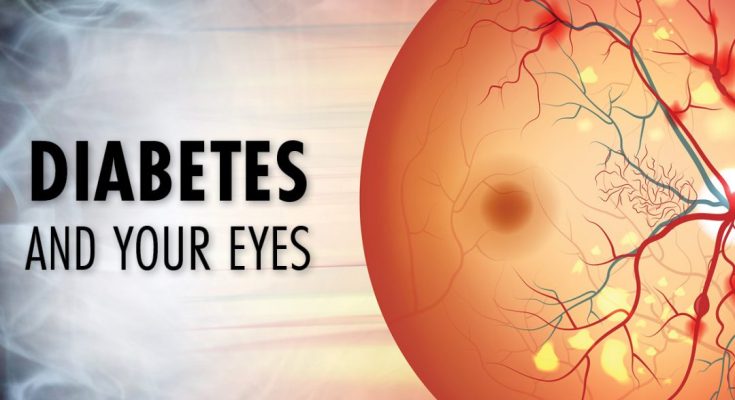Millions of people across the world suffer from diabetes, which is a chronic condition. It is related to blood glucose (sugar) levels. If these levels are unchecked, several health issues may arise. One of these Unique and dangerous diseases is diabetic retinopathy.
Diabetes is the killer that silently kills parts of your life.
Diabetes and eye problems are associated with each other. Diabetic patients are at risk for many eye diseases like diabetic retinopathy, cataracts, and glaucoma.
Damage of eye vessels due to diabetes
All of these conditions may lead to vision loss, but early detection and treatment can significantly improve the chances of keeping your sight.
Dreams and Sleep: How It Affects a Person’s Well-Being. Make Sure to Read to my Latest post regarding Sleep and Dreams of Your Life.
How does diabetes affect the eyes?
Insulin is a hormone that carries glucose, i.e. blood sugar, to your body’s cells. When you have diabetes, your body neither responds to it nor creates it. If excessive blood is outside your cells, many areas of the body, including blood vessels and nerves, and the eyes are most commonly affected.
Diabetic Retinopathy
Diabetic retinopathy is commonly found as a cause of blindness in working-age people. In this condition, high blood sugar weakens the retina’s blood vessels. As a result, a sensitive light layer of cells is formed in the eye’s back (diabetic retinopathy).
Blood flow may be stopped or eyesight may become blurry as a result of swollen, leaking, and damaged blood vessels. In this case, new blood vessels can often form but are not always healthy. It can worsen existing visual issues. Diabetic retinopathy impacts both eyes.
What are the Stages of Diabetic Retinopathy?
There are 2 main stages of Diabetic Retinopathy. These are:
Early stage or First stage
In this stage, the walls of the blood vessels in the retina become weakened and form tiny pouches, which can only be detected by a doctor. Blood and other fluids may leak from these tiny pouches and swell the macula, causing macular edema.
The macula is a part of the retina. Almost 50% of patients with diabetic retinopathy have macular edema. This stage usually doesn’t have symptoms, but some patients notice vision changes.
Advanced stage or Second stage
The retina starts to produce new blood vessels at this stage. Because they are weak, these new vessels frequently bleed into the vitreous (the transparent gel between the retina and lens). You may notice a few floating dark spots in your vision with mild bleeding. Excessive bleeding may completely block your vision.
Advanced stage symptoms include:
- Blur vision
- Vision clouded with dark shapes or spots
- Color sense issues
- Void or dark areas in your vision
- Loss of vision
How to Treat Diabetic Retinopathy?
In most cases, treating diabetic retinopathy can cure eye damage and even prevent blindness. As a result, vision loss can be avoided, and treatment can start before your vision is affected. The following are your options:
- Treatment (laser photocoagulation). A scar tissue barrier is created, which slows down the development of new blood vessels.
- Complete or partial vitreous removal (vitrectomy)
- Corticosteroid injections
- VEGF inhibitors help slow down diabetic retinopathy.
- The retinas reattachment in case of complication i.e. retinal detachment.
Other eye problems through diabetes:
Besides diabetic retinopathy, there are other problems as well that are caused by diabetes. These may include the following:
Cataract
When a normally transparent eye lens experiences clouding, it is a sign of a cataract. Although everyone experiences a kind of cloudy vision in old age, people with diabetes are more likely to develop cataracts at an early age. High blood sugar may lead to particles forming in the lenses and clouding them.
The only option to repair cataracts is surgery. The good news is that it’s safe, and most people have recovered from it with improved vision.
Glaucoma
A group of eye diseases is known as glaucoma. It harms the optic nerve because of excessive pressure on the eye. Many forms of glaucoma have no symptoms and vision loss may begin such slowly that you’re unaware of it
The most common type of glaucoma is open-angle glaucoma found in diabetic patients. Neovascular glaucoma can also be brought on by diabetes. Glaucoma cannot be prevented although treatment can slow down its progress. Due to this, early glaucoma detection is important. Treatment can be surgery, laser therapy, or medicine as well.
Eye lens swelling
Diabetes may also cause eye lens swelling, which may result in blurry vision. Your eye lens may change shape and your vision may become blurry if your blood sugar goes from low to normal quickly. When your blood sugar stabilizes your vision becomes normal again.
How Diabetes causes bloodshot eyes?
The blood vessels of the entire body may be harmed by diabetes. When sugar stops the smallest blood vessels which are leading toward the retina, it damages your eyes by causing them to bleed. Your eyes then develop new, poorly functioning vessels to compensate for these blocked blood vessels.
Tips to Prevent diabetic eye diseases:
By doing the following actions, you can maintain your vision and reduce your risk of vision loss:
- Schedule your eye check-up at least once a year. It will also help your doctor detect any problem at its early stage.
- Try to keep your blood sugar levels within the desired range as much as possible.
- Maintain proper blood pressure and cholesterol levels to reduce the risk of eye diseases. Additionally beneficial for your overall health.
- Giving up smoking reduces your risk for diabetic eye diseases and enhances your health in numerous other ways
- Engage yourself in workouts. Exercise helps to control diabetes and protect your eyes.
In summary, numerous eye issues, such as diabetic retinopathy, macular edema, cataracts, and glaucoma caused by diabetes. Hence, diabetes and eye problems are linked with each other. If it is left untreated, this disease can cause vision loss. Therefore people with diabetes need to take their condition seriously and take action to control it effectively. It is important to get regular eye exams and follow treatment guidelines to maintain blood sugar levels. Many diabetics can protect their vision and retain good eye health with proper management.




Your articles are extremely helpful to me. Please provide more information!